×
The Standard e-Paper
Join Thousands Daily

With pride, James Omollo stands by the shores of Lake Victoria, directing his attention towards two floating fish cages. As he recounts their impact on his life and that of his family, his face lights up with delight.
These cages have become the catalyst for transforming his fortunes and contributing to the local market's demand for fresh fish, which has been plagued by diminishing stocks in natural waters.